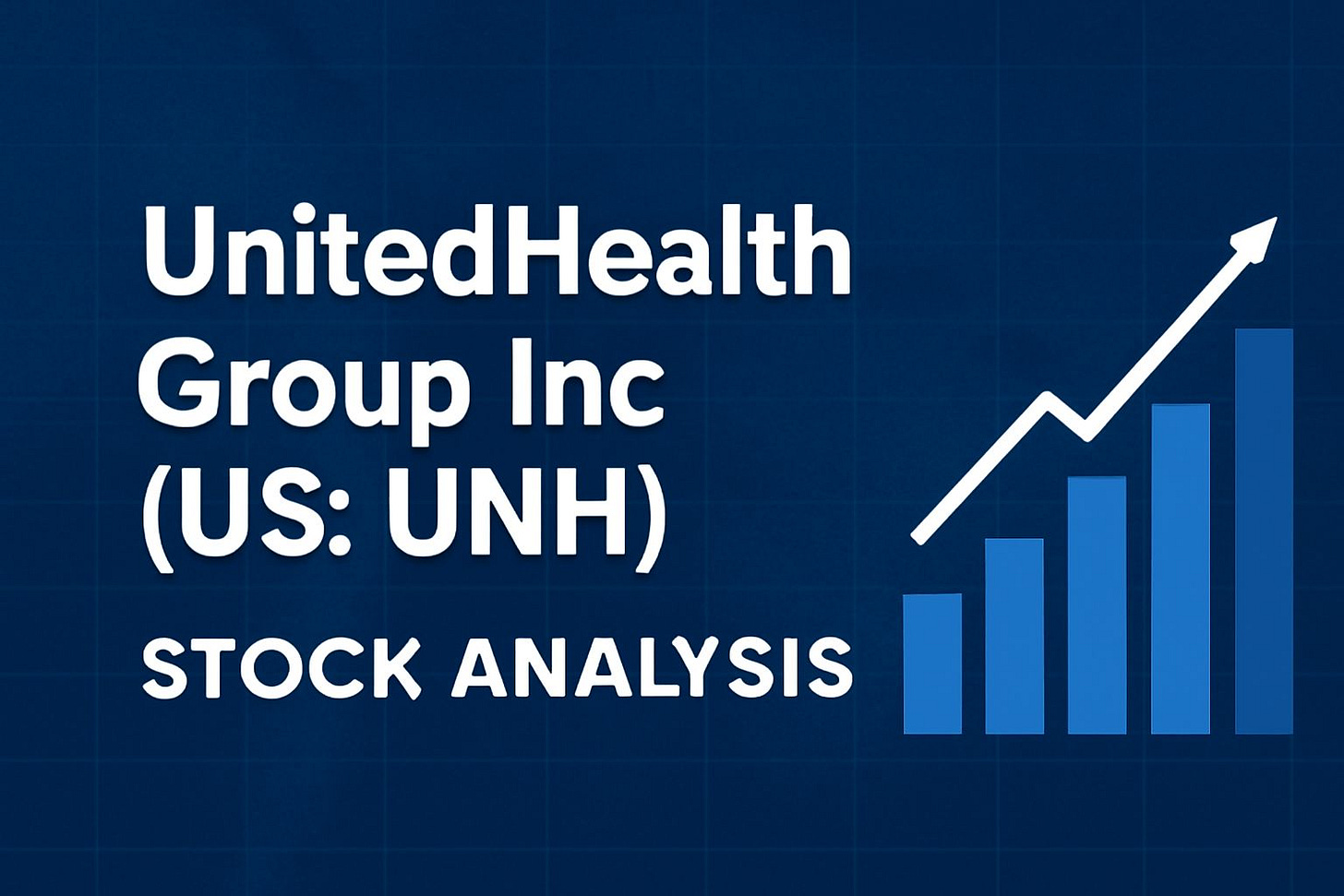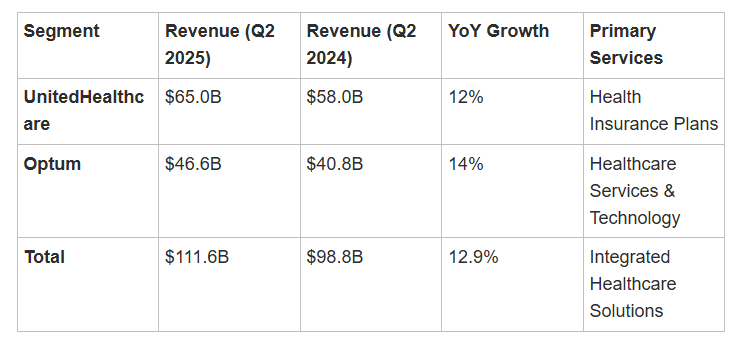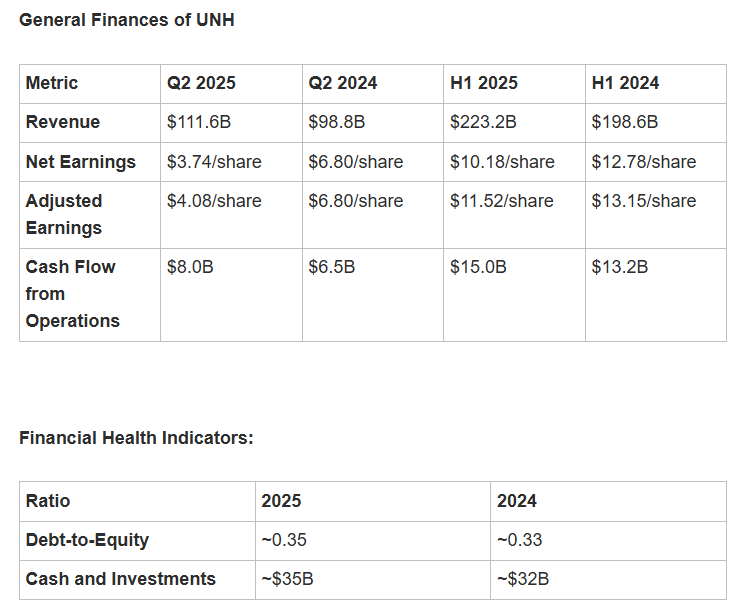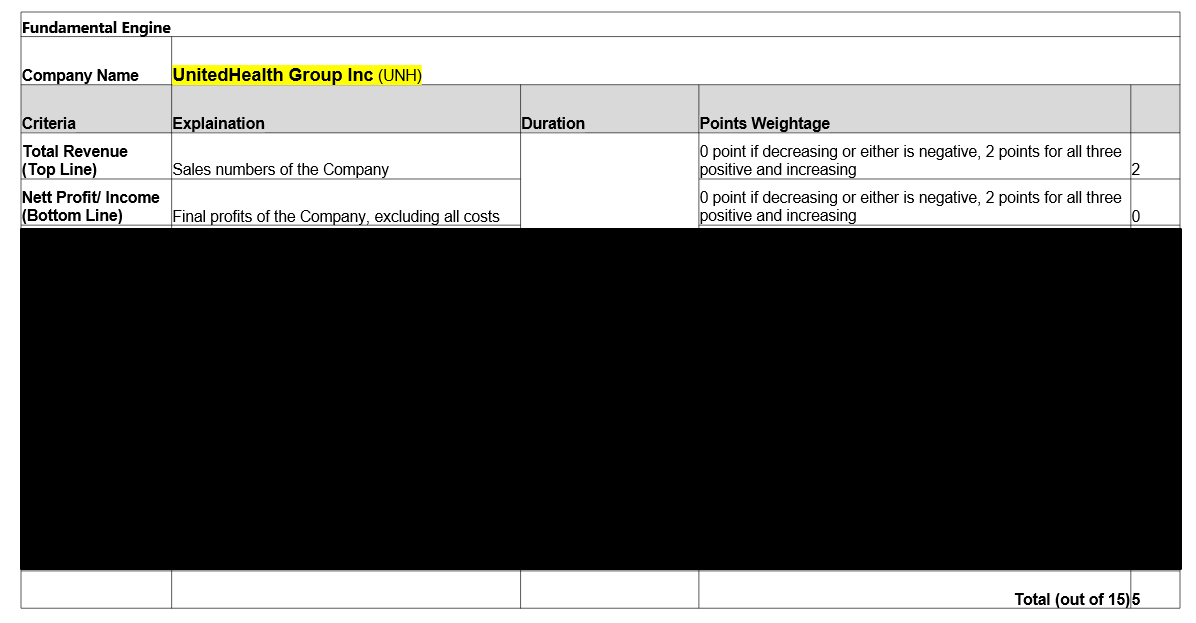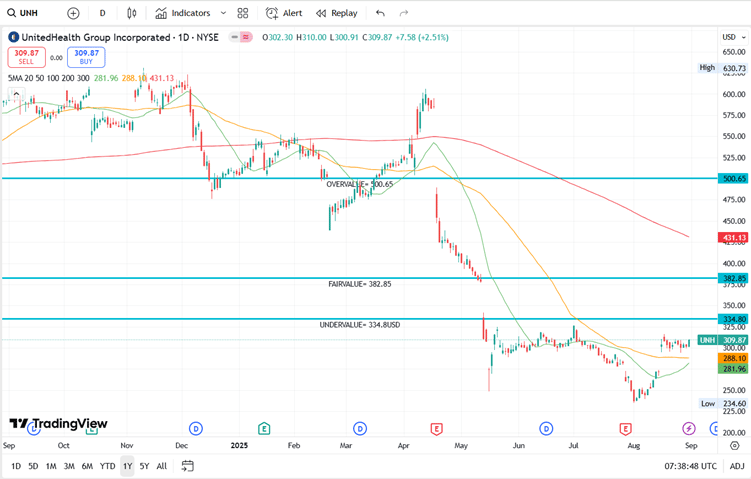UnitedHealth Group Inc. (NYSE: UNH)
Updated October 2025
Company Profile
UnitedHealth Group Incorporated is an American multinational managed healthcare and insurance company based in Minnetonka, Minnesota. Founded in 1977 by Richard T. Burke, UnitedHealth Group has grown to become the largest healthcare company in the United States by revenue and the world's largest health insurer by market capitalization.
The company operates through two primary business platforms: UnitedHealthcare, which provides health care coverage and benefits services, and Optum, which provides information and technology-enabled health services. UnitedHealth Group serves over 150 million people globally across all 50 U.S. states and internationally.
For the second quarter of 2025, UnitedHealth Group reported revenues of $111.6 billion, representing a 12.9% increase year-over-year. The company has re-established its full-year 2025 outlook after suspending guidance in May, projecting revenues between $445.5 billion and $448.0 billion.
The company serves individuals, employers, government programs, and healthcare providers through a diversified portfolio of products and services spanning health insurance, healthcare delivery, pharmacy benefits management, data analytics, and technology solutions.
Business Segments
UnitedHealthcare:
Commercial Health Insurance
Medicare Advantage
Medicaid Plans
International Operations
Optum:
OptumHealth (Healthcare Delivery)
OptumInsight (Data Analytics & Technology)
OptumRx (Pharmacy Benefits Management)
Business Segments & Revenue
All revenues are in billions USD
The revenue breakdown shows strong growth across both major segments, with Optum continuing to drive significant expansion through its diversified healthcare services portfolio. UnitedHealthcare maintains its position as the core revenue generator while Optum represents the growth engine for future expansion.
How have the individual segments been performing throughout the years?
All revenues are in billions USD
The historical data shows consistent revenue growth across both segments. UnitedHealthcare has demonstrated steady expansion in its core insurance business, while Optum has emerged as a significant growth driver, representing nearly 42% of total company revenue in the first half of 2025.
Is UNH still a strong company?
UnitedHealth Group has demonstrated resilience and market leadership in the healthcare sector through:
Market Leadership: Largest health insurer in the U.S. with over 50 million members
Diversified Business Model: Balanced portfolio across insurance and healthcare services
Integrated Care Delivery: Vertically integrated model through Optum's care delivery platforms
Strong Membership Growth: Consistent expansion across commercial and government programs
Technology Investment: Significant investments in healthcare technology and data analytics
Despite facing challenges in 2025, including the suspension and subsequent re-establishment of guidance, UnitedHealth Group has maintained its position as a dominant force in healthcare. The company experienced operational challenges in the first half of 2025 related to higher care trends but has outlined a "rigorous path back to being a high-performing company."
Efficiency of UNH
Estimated based on available data
UNH Efficiency Metrics:
Medical Care Ratio: Increased to approximately 84-85% due to higher care utilization trends
Operating Cost Management: Maintained disciplined cost structure despite revenue growth
Administrative Efficiency: Continued focus on operational excellence and technology integration
The company has experienced some margin pressure in 2025 due to higher medical costs and care trends, but maintains strong operational fundamentals and has outlined plans to return to historical performance levels.
Strongest Moat of UNH
UnitedHealth Group maintains significant competitive advantages through:
Scale and Network Effects - Largest membership base providing negotiating leverage with providers
Vertical Integration - Integrated model spanning insurance, care delivery, and technology
Data and Analytics Capabilities - Extensive healthcare data assets through Optum platforms
Provider Network - Comprehensive network of healthcare providers and facilities
Technology Infrastructure - Advanced healthcare technology platforms and digital health solutions
Regulatory Expertise - Deep experience navigating complex healthcare regulations
Capital Allocation - Strong balance sheet enabling strategic investments and acquisitions
Revenue Distribution by Geography (2025)
United States: ~95% (Primary market focus)
International: ~5% (Brazil, Europe, and other markets)
UnitedHealth Group's revenue is primarily concentrated in the U.S. healthcare market, with limited but growing international exposure through select markets and partnerships.
UnitedHealth Group maintains a solid financial foundation with strong cash generation capabilities, though earnings per share declined in Q2 2025 due to higher medical costs and operational challenges.
Possible Growth Opportunities
Medicare Advantage Expansion The aging U.S. population presents significant opportunities for Medicare Advantage growth, with UnitedHealth Group well-positioned to capture market share through its comprehensive offerings.
Value-Based Care Continued expansion of value-based care arrangements through Optum's provider networks and technology platforms, enabling improved outcomes and cost management.
Digital Health Innovation Growing investments in digital health technologies, including telehealth, remote monitoring, and AI-powered healthcare solutions.
International Expansion Selective expansion in international markets, particularly in emerging economies with growing healthcare needs.
Healthcare Technology Continued development of healthcare technology solutions through Optum, including data analytics, workflow optimization, and care management platforms.
Pharmacy Integration Further integration of OptumRx with care delivery platforms to create comprehensive pharmacy and medical management solutions.
Risks
Regulatory and Political Environment
Healthcare Policy Changes: Potential changes in healthcare legislation affecting Medicare Advantage and ACA markets
Government Relations: Ongoing Department of Justice investigations into Medicare billing practices
Rate Regulation: Regulatory scrutiny of premium rates and medical loss ratios
Key Risk Factors:
Medical Cost Inflation affecting profitability across insurance segments
Competition from new entrants in health insurance and healthcare services markets
Cyber Security Risks given extensive healthcare data holdings
Provider Relations and potential conflicts with healthcare systems
Economic Recession Impact on employer-sponsored health plans
Technology Integration Challenges across acquisitions and platforms
Valuation
Current Metrics (as of August 2025):
P/E Ratio: ~20-22x (based on forward earnings)
Price-to-Book: ~3.2x
Market Capitalization: ~$480 billion
Historical Context:
Stock has experienced volatility in 2025 due to operational challenges and guidance revisions
Trading at discount to historical multiples due to near-term headwinds
Valuation reflects concerns about medical cost trends and margin pressure
Investment Outlook
UnitedHealth Group represents a defensive healthcare play with long-term growth potential despite near-term challenges. The company's market leadership, diversified business model, and integrated care delivery platform provide competitive advantages in the evolving healthcare landscape.
However, investors should consider the current operational challenges, including elevated medical costs and the recent suspension of guidance, which indicate near-term headwinds. The company's commitment to returning to historical performance levels and earnings growth in 2026 suggests management confidence in addressing current issues.
Key Investment Considerations:
Market Leadership: Dominant position in U.S. health insurance with defensive characteristics
Diversification: Balanced revenue streams across insurance and healthcare services
Long-term Demographics: Favorable trends from aging population and healthcare digitization
Near-term Headwinds: Medical cost inflation and operational challenges requiring monitoring
Valuation Opportunity: Trading at discount due to temporary factors
Kintsugi Analysis
(I) Fundamental Analysis Score: 5/15
(II) Portfolio Allocation
Avoid, Add to watchlist and wait for recovery
(III) Valuation
NOTE: We teach our fundamental analysis and valuation methods in our classes. Find out more here.
IMPORTANT DISCLAIMER: By reading this document, you agree that any information, commentary, recommendations or statements of opinion provided here are for general information and education purposes only.
The information contained in this publication are obtained from, or based upon publicly available sources that we believe to reliable, but we make no warranty as to their accuracy or usefulness of the information provided, and accepts no liability for losses incurred by readers using our case studies.
It is not intended to be financial advice, personalized investment advice or a solicitation for the purchase or sale of securities. Before purchasing any discussed securities, please be sure actions are in line with your investment objectives, financial situation and particular needs. Please do your own research and speak with a licensed advisor before making any investment decisions.
International investors may be subject to additional risks arising from currency fluctuations and/or local taxes or restrictions.
Please remember that investments can go up and down, including the possibility that a stock could lose all of its value. Past performance is not indicative of future results.


